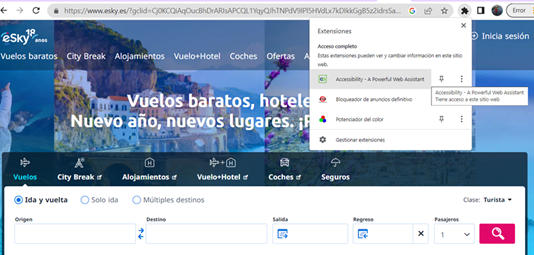Algumas ferramentas que facilitam a navegação
Já ouviu falar de acessibilidade da Web?
De acordo com W3.org ³: “A acessibilidade da Web significa que os sítios Web, as ferramentas e as tecnologias são concebidos e desenvolvidos de modo a que as pessoas com deficiência os possam utilizar. Mais especificamente, as pessoas podem::
- perceber, compreender, navegar e interagir com a Web
- contribuir para a Web”
De facto, uma Web acessível não serve só as pessoas com deficiência, mas também as pessoas com limitações temporárias e situacionais (adaptações, por exemplo, um braço partido ou óculos perdidos; alteração das capacidades devido à idade; luz solar intensa ou ambiente demasiado ruidoso; Internet lenta ou ecrã pequeno, etc.).
Ao descrever algumas das principais características das plataformas de reserva, salientámos a facilidade de utilização das plataformas e a sua facilidade de navegação. A maioria das grandes marcas faz o seu melhor para ser acessível e para adaptar as características dos seus sítios Web às necessidades dos utilizadores. No entanto, muitos sítios Web por vezes não cumprem os requisitos de acessibilidade mais importantes: bom contraste de cores, sítio Web reativo (adapta-se ao tamanho do ecrã), tipos de letra legíveis, legendas de vídeo e alternativas de texto para imagens, funcionalidade do teclado, etc.
Felizmente, como utilizadores da Internet, nós próprios podemos melhorar a acessibilidade da Internet através das definições, personalizações e extensões do navegador.
Lembre-se, quando falámos sobre como verificar a segurança de um sítio Web, mencionámos o URL. Este é introduzido no browser, um programa que nos permite navegar na Web. Os browsers mais populares e mais utilizados são o Google Chrome, o Mozilla Firefox, o Microsoft Edge, o Apple Safari e o Opera. Por vezes, é mais útil personalizar as definições do computador ou da plataforma móvel (Windows, macOS, Android e iOS).
Uma extensão do navegador é um pequeno software que adiciona funcionalidades personalizadas ao navegador principal, como um modo escuro, um corretor ortográfico, um bloqueador de anúncios e muito mais.
Embora os navegadores e as plataformas sejam diferentes, todos eles oferecem funcionalidades de acessibilidade semelhantes:
- Aumentar o tamanho do tipo de letra para se adaptar às suas necessidades de leitura sem redimensionar imagens ou outros suportes;
- O zoom aumenta todas as partes do ecrã. No browser, a página pode ser aumentada até 500%
- Utilizar o modo de alto contraste, que inverte as cores para facilitar a leitura para algumas pessoas
Se não conseguir encontrar algumas destas funcionalidades nas definições do seu browser, pode consultar as definições da plataforma. Outra opção é adicionar algumas extensões ao seu browser.
De seguida, apresentamos algumas das extensões ou complementos que podem melhorar a acessibilidade de uma página Web:
1. Helperbird
Tem um plano gratuito que oferece uma vasta gama de ferramentas para personalizar a página Web de acordo com as suas necessidades e melhorar a sua acessibilidade:
- Funções de texto: tipos de letra especializados para leitura; tipos de letra para dislexia; alinhamento de texto; espaçamento entre palavras e letras;
- Funções de conteúdo: modo de leitor; Microsoft Immersive Reader (melhora a leitura); remove anúncios e distrações de qualquer página; dicionário de imagens; o Google traduz para mais de 100 idiomas;
- Funções de visualização: realçar links; controlos de daltonismo; ocultar imagens;
- Funções de voz para texto: Text-to-speech (um tipo de tecnologia de assistência que lê textos digitais em voz alta); amplificador de volume de áudio e vídeo na página;
- Funções de cor: realçar e selecionar cores..
Se seguir este link, pode instalar esta extensão no seu navegador Chrome, bem como encontrar um vídeo útil sobre esta ferramenta. Se utilizar outro navegador, consulte aqui a instalação.
2. Acessibilidade – um poderoso assistente Web (uma extensão do Chrome)
Esta é uma excelente ferramenta gratuita para adicionar ao seu navegador que personalizará a navegação de acordo com as suas necessidades, com as seguintes características
- Ajuste do tipo de letra – permite-lhe alterar o tipo de letra, e decidir se prefere a negrito ou não;
- Alternância de animação – permite desativar todas as animações irritantes da página Web;
- Contraste de cores – permite-lhe alterar o fundo, o texto e o link predefinidos;
- Texto para voz – permite ler em voz alta o texto da página com mais de 200 definições de voz;
- Matizes e sobreposições – uma régua de sobreposição que permite seguir facilmente o texto no ecrã e bloquear o conteúdo que distrai.
Pode descarregar esta ferramenta aqui e executá-la a partir do seu browser.

3. Ultimate Ad Blocker (extensão para Chrome, também disponível para Firefox)
É uma ferramenta gratuita que permite bloquear anúncios, banners, pop-ups, pre-rolls e outros anúncios em diferentes sítios Web, incluindo o YouTube.
Pode descarregá-la e instalá-la aqui.
4. Google tradutor
Imagine que navega no sítio Web oficial de um hotel alemão e que a sua língua materna não está disponível. Então, esta ferramenta gratuita será muito útil, pois permite-lhe ver as traduções enquanto navega. Basta clicar no botão traduzir na barra de ferramentas do seu navegador para traduzir a página que está a visitar. Siga este link para descarregar o Google Tradutor.
Estas são apenas algumas extensões que podem ser úteis para uma melhor experiência de navegação. No entanto, existem muitas mais e pode procurá-las na Loja Web do Chrome para a Acessibilidade ou na App Store.
